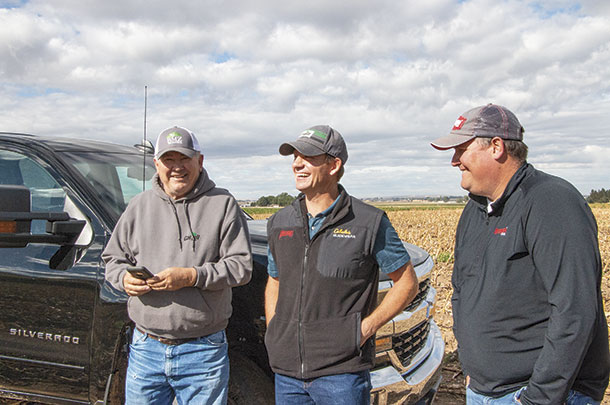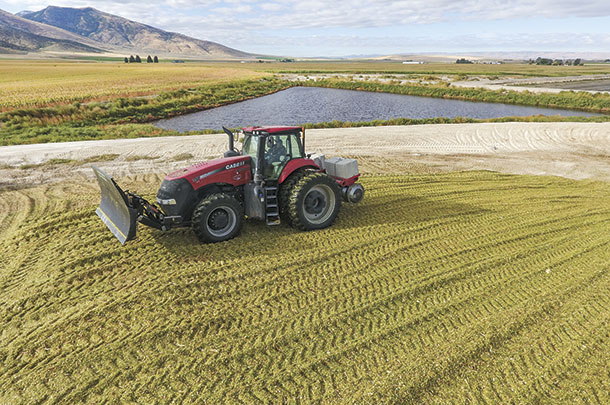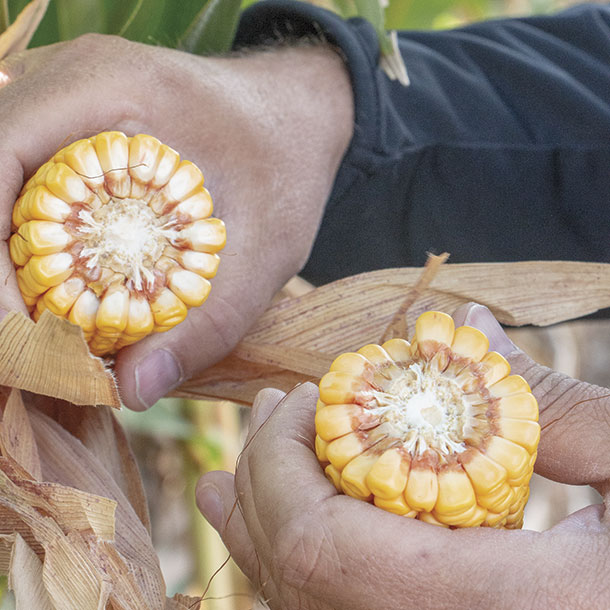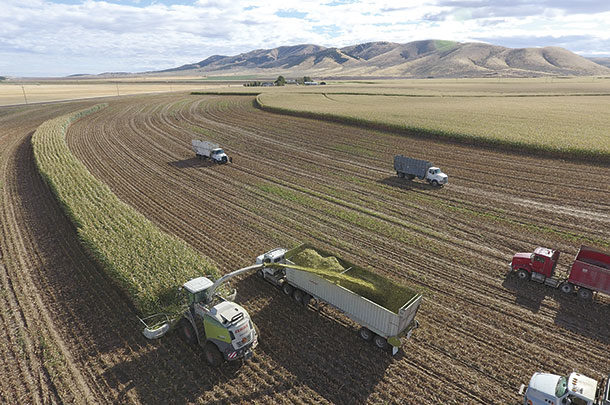With 6,200 milking cows on 3,000 acres of high-moisture corn and alfalfa, Robinson looks for any advantage for higher rates of return, and that’s what makes him and his dairy partners early adopters.
So when Mycogen was looking for producers to try their new BMR corn silage (Unified with SilaSoft technology), Ray, as a regular Mycogen customer, was on board early. He says, “A lot of researchers use small test plots, and that’s OK. But my idea of a test plot is a pivot.”
 Robinson was sold on BMR silage varieties several years ago. “We raise a lot of BMR because we feel like we get better digestion out of the stalk portion of the BMR with lower lignin,” he says. “This year, some new stuff came down the pike, and they thought we might get better yield out of it and should get more milk out of it.
Robinson was sold on BMR silage varieties several years ago. “We raise a lot of BMR because we feel like we get better digestion out of the stalk portion of the BMR with lower lignin,” he says. “This year, some new stuff came down the pike, and they thought we might get better yield out of it and should get more milk out of it.
So we tried some.” Robinson’s nutritionist, Shane Holt of Cargill, worked with Moo Mountain’s farming partner, Lavell Stoker, to develop the 2017 growing season game plan.
Robinson generally plants about 75 to 80 percent BMR and about 20 percent conventional silage varieties, while most dairies in the area raise conventional corn silage varieties. “But Lavell understands how to raise BMR, and there’s a trick to raising BMR,” Robinson says. “If your management style is to maybe stress a crop – put the water on it later or something like that – then BMR won’t work for you.”
The new variety Robinson tested was developed with naturally occurring genes. Eric Frasure, Mycogen agronomist, says, “The environment in the rumen normally favors either starch microbes at the detriment of fiber microbes or vice versa. SilaSoft technology allows for starch microbes to digest in a fiber environment or fiber microbes to digest in a starch environment.”
 Robinson used a seeding rate for the new product in his silty loam soils of 40,000 plants per acre. Robinson says, “Some people back East will tell you that’s too much. But here in the West, it is not. We’ve run some trials starting at 30,000 to 32,000 plants and went to 40,000 to 46,000 plants, but found in our area about 40,000 plants per acre was right.
Robinson used a seeding rate for the new product in his silty loam soils of 40,000 plants per acre. Robinson says, “Some people back East will tell you that’s too much. But here in the West, it is not. We’ve run some trials starting at 30,000 to 32,000 plants and went to 40,000 to 46,000 plants, but found in our area about 40,000 plants per acre was right.
We have better soil and better growing conditions that will support the higher rate.” Robinson says on some areas of the farm, conventional corn will out-yield BMR, but on “really good ground” BMR will out-yield conventional corn silage by a couple tons per acre.
As for the growing season for the new variety, Robinson says, “We didn’t do anything different than we do for any other year’s crop.” It was irrigated and fertilized basically the same as other varieties.
Frasure says, “We recommend producers plant Unified in the best growing conditions available with good fertility and access to moisture. It also should be grown together and stored together. Producers should avoid split-planter situations and mixing it with other corn silage during harvest.”
When harvest season rolled around, Robinson’s harvest crew used three harvesters with kernel processors and targeted at least 30 percent dry matter, with a preference for 34 to 35 percent.
Robinson says, “We are believers in kernel processors and run kernel processors on our three 980 Claas harvesters. We check to make sure they’re processing right, and if they’re not, we adjust it tighter. As the season goes on and kernels get more mature, you have to close your processors down. You don’t just set them in one spot and forget them through the season. It’s something you watch every day and re-adjust as you’re going.”
The only glitch during harvest came when a heavy wind came through a mature stand of BMR, which made the BMR tip over where it became tougher to harvest. “But,” Robinson stresses, “that was a really heavy wind.” In the first year of use, Robinson says the new BMR yielded about the same tonnage as other varieties he has tried.

Moo Mountain Milk Inc. is set up with two milking parlors so, to test the feed quality, the intent was to feed the new product to the cows in one facility and continue feeding their usual silage variety to the other half for a few months, then switch sides. Cargill nutritionist Shane Holt had worked with John Anderson, Mycogen’s nutritionist, to work out the feeding plan.
One of the purported advantages to the new BMR variety is its claim to need a shorter ensiling time for fermentation – about six weeks. Robinson normally doesn’t feed new-crop silage until about Jan. 1, or three months after harvest. He anticipated the shorter ensiling time as an advantage, especially in years when feed is running short.
Moo Mountain Milk Inc. produces most of the foodstuffs that go into their dairy ration but purchases some silage, barley and alfalfa from area farmers. While wheat distillers and a few commodities come from the Midwest, the dairy raises its own dairy-quality hay; any alfalfa that is “feeder hay” is processed through feedlots of 10,000 to 12,000 head of heifers.
Unfortunately, when it came time to feed out the new BMR, other factors were also changing at the dairy, including changing barley suppliers, discontinuing the use of rBST and a few other changes, so practical evaluation of milk production on the new BMR alone wasn’t accessible.
Although Moo Mountain Milk Inc. didn’t see any change in the cows or milk production, Robinson said he was pleased with the quality at feedout.
A research project was conducted at William H. Miner Agricultural Research Institute in Chazy, New York, looking at the lactational performance and feed efficiency in Holstein cows using the new floury kernel genetics of BMR corn silage.
The results of that study indicated cows fed the BMR corn silage with floury kernel genetics gained better feed efficiency over cows fed the control BMR corn silage, due to presumably greater ruminal carbohydrate fermentability and increased microbial fermentation. ![]()
PHOTO 1: In the high desert of southern Idaho, silage harvest is underway in the 2017 harvest season of the “test plot,” which spans an entire center pivot.
PHOTO 2: Ray Robinson consults with Cargill nutritionist Shane Holt and Mycogen agronomist Eric Frasure to discuss next steps in feed management.
PHOTO 3: Moo Mountain Dairy crews pack the silage pit of a new BMR hybrid variety, hoping to increase feed efficiency in the herd.
PHOTO 4: As an early adopter of new technology, Moo Mountain Milk tried a new BMR corn silage variety in the 2017 silage season. Photos by Lynn Jaynes and Ray Merritt.

-
Lynn Jaynes
- Editor
- Progressive Dairyman
- Email Lynn Jaynes











